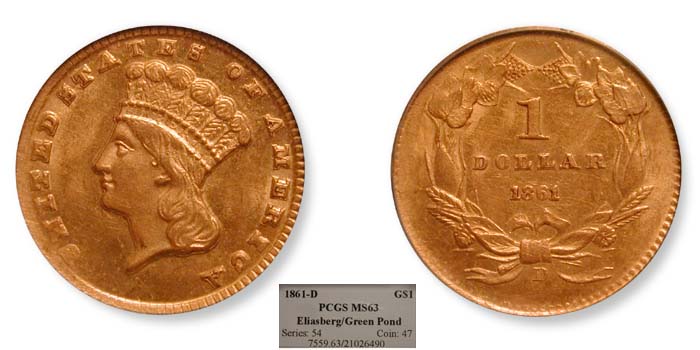1861-D G$1 MS63 认证号21026490, PCGS号7559
拥有者评论
Tied for second highest graded at PCGS.
专家评论
David Akers (1975/88)
With the exception of the uncollectible 1849-C Open Wreath, the 1861-D is generally considered to be the "king" of the gold dollar series. Certainly when offered for sale, it invariably brings a higher price than any other date in comparable condition. However, in my opinion, it is no more rare than the 1856-D and actually is much less rare in uncirculated condition. Several very choice uncirculated 1861-D's are known with the incredible Ullmer coin (purchased by Stanley Kesselman) being the finest that I have ever seen. The exact mintage of the 1861-D is not known since the coins were struck after the Confederacy had taken over the Dahlonega Mint. However, judging from the number of specimens known compared to the number known of the 1856-D and 1860-D, I would estimate the mintage to have been somewhere between 1,200 and 1,500 pieces. Most known specimens are weakly struck, and the U in UNITED on the obverse is invariably weak or even missing.Doug Winter
The 1861-D is the rarest Dahlonega gold dollar. It is also the best known and most famous issue from this mint because its entire mintage was produced by the Confederate States of America.The Dahlonega Mint was seized by the Confederacy in April, 1861. Shortly thereafter, a small quantity of gold dollars was struck by the rebel forces. The number of surviving examples (coupled with the assumption that a number of coin were almost certainly saved as souvenirs) has led experts to guess that the mintage figure was somewhere in the area of 1,000-1,500 coins.
This is a rare coin in all grades. The number of high grade specimens is greater than normal for an issue with this small a mintage, suggesting the existence of a small hoard. While sometimes available in Mint State, any Uncirculated 1861-D gold dollar must be considered among the most important and desirable Dahlonega issues imaginable.
STRIKE: The 1861-D gold dollar was struck using a leftover 1860-D obverse. This crude die and the Rebels' lack of minting expertise made for a poorly produced issue. On all known examples the U in UNITED is very faint and the N is quite weak. The rest of the letters are bolder, although the IC in AMERICA is sometimes weak. Liberty’s hair always shows weakness as do the plumes, but they tend to be a bit better detailed than on the 1860-D. The milling is sharp from 12:00 to 6:00 and weak at the left side. On the reverse, the wreath is sharp except for the outside portions which have been polished away and the bow is somewhat thin but sharp. The milling is only slightly visible at 2:00 to 6:00. The left ribbon end is separated due to die polishing. The date is small but sharp while the mintmark is small and high. Both the obverse and the reverse sometimes show clashmarks at the center.
SURFACES: Most 1861-D gold dollars have below average quality surfaces. The quality of the planchets used to strike these coins was not very high and the fact that they were produced by amateur minters makes it easy to see why many have splits, cracks or other defects. Most are grainy below and around the head of Liberty.
LUSTER: The quality of the luster is much better than one might imagine, given the circumstances of the minting process. Higher grade pieces tend to display thick, frosty luster.
COLORATION: The coloration observed on uncleaned, original 1861-D gold dollars ranges from rich yellow-gold to orange-gold to deep green-gold. As with most rare, popular issues, the majority of the survivors have been cleaned or dipped. The few totally original pieces that exist are much coveted by collectors and are valued at a substantial premium.
EYE APPEAL: The concept of ‘eye appeal’ is essentially meaningless when describing this issue. While some are much more ‘appealing’ than others, they are crude and primitive in comparison to a Philadelphia product of this era.
PERSONAL OBSERVATIONS: Most Dahlonega gold coins become progressively rarer based on their grade. In other words, the typical issue is more likely to be seen in Very Fine to Extremely Fine than in About Uncirculated to Mint State. The opposite is true with the 1861-D dollar. It appears that more than half of the known specimens grade About Uncirculated-50 or better and as many as a dozen different Uncirculated pieces exist. Clearly, the 1861-D was saved as a souvenir by locals who, even then, knew it was a special issue.
DIE VARIETIES: All 1861-D gold dollars were struck from a single pair of dies in May, 1861.
Variety 12-Q: The obverse is the same as described above for the 1860-D gold dollar. The U in UNITED is faint and the N in this word is weak. On the reverse, the date is small and is positioned somewhat to the left. The first 1 is under the left side of the first L in DOLLAR. The mintmark is small and it is placed high. The mintmark tilts plainly to the right and is very close to the right ribbon end.
PCGS #
7559
设计师
James Barton Longacre
边缘
Reeded
直径
14.30 毫米
重量
1.70 克
铸币数量
1000
金属成分
90% Gold, 10% Copper
更高评级数量
2
评级较低的钱币数量
58
地区
The United States of America
价格指南
PCGS 数量报告
拍卖 - PCGS 评级的
拍卖 - NGC 评级的
稀有性和存量估计 了解更多
| 所有评级 | 75 |
| 60或以上 | 15 |
| 65或以上 | 1 |
| 所有评级 | R-8.2 |
| 60或以上 | R-9.3 |
| 65或以上 | R-10.0 |
| 所有评级 | 1 / 49 TIE |
| 60或以上 | 9 / 49 TIE |
| 65或以上 | 1 / 49 TIE |
| 所有评级 | 2 / 81 TIE |
| 60或以上 | 17 / 81 TIE |
| 65或以上 | 1 / 81 TIE |





















